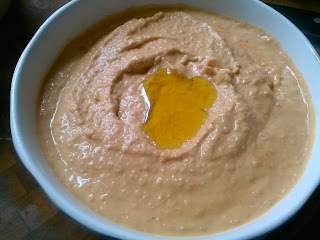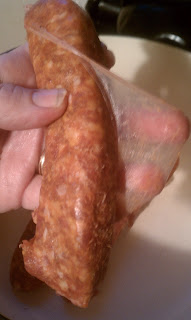My love for old houses predates Rehab Addict, though. One of the reasons that we bought this house was because it had a decidedly non-open floor plan. I like formal dining rooms and living rooms that were once called "parlors" and probably only used on Sunday afternoons, or maybe for tea on other days. I love front porches where people used to actually sit and meet with neighbors. I love wood floors and mahogany trim and wavy glass windows.
Alas, I live around the turn of the century, but not the one when this house was built.
We don't heat our homes with wood stoves anymore. So we have to worry about energy efficiency, lest our gas bill top $200 a month. Old wood windows with wavy glass just didn't keep our bills down (I think our highest ever was about $620, after a particularly cold month). We lead busy lives with our busy kids, and yet expect everything to be neat and tidy, often forgetting how the lack of a garage and the unpaved driveway make this nearly impossible. We now know the dangers of asbestos and lead-based paint, plenty of which has been used in houses that have passed their hundredth birthdays.
So I don't have the luxury of being a restoration purist, and we have had to make adjustments. A few years ago, we put up vinyl siding to cover the cement shingle siding that most likely contained asbestos, and that had been covered in lead paint. We couldn't remove and replace them because of the cost of asbestos abatement, and we couldn't scrape and repaint them because of lead. The only thing that we could do was contain it (it's harmless if you just leave it alone), and vinyl was the only cost-efficient option for us. I am happy with it, but I imagine that many restoration devotees would shiver at the thought. To really give them the willies, we also had vinyl window replacements installed. Again, it just wouldn't have made sense, cost-wise, to replace with expensive wood windows. The neighborhood just wouldn't have supported it in resale value, even if we could have afforded it, To save energy, and also just to be able to get some fresh air in the house (most of the windows were painted shut), we did the only thing that we could do, and that was vinyl replacements.
It was probably around that time that I really started to fall in love with old stuff. Obviously, I already had a fondness, but it went into high gear at this time. My hands were tied on a lot of things, but I managed to hang on to my front door, and I suddenly started noticing how absolutely beautiful wavy glass is. How it distorts the view of the leaves fluttering on the trees in the most fascinating way.
 |
| A small concession to the energy savings, but totally worth it. |
It was then that I decided that I could not let this piece of history go into the trash heap. We had to get rid of the windows because of the lead paint content. But there was nothing wrong with the glass itself. So I began painstakingly cutting the glazing out around the windows, trying my best to avoid those pesky metal tips that were intended to hold the glass in the frame, but had the frustrating effect of starting a long, instant crack in the glass if you hit it with the knife just right. Of course, I could only do the non-essential windows at first, like the porch and the shed. The rest of the windows had to be done in one weekend, right before the new ones came to replace them. Fortunately, we have good friends who came and helped us.
Why would I want to store all of that glass? Well, at first I was hoping to sell it. There are plenty of people who are restoring historical homes, who would love to have antique glass to use in their custom built windows.
But apparently not in Grand Rapids.
Still, I couldn't just throw it in the trash. So I decided that I would use it, as much as possible, in the house. The cupboards over our mudroom will have glass doors, as well as some of the cupboards in an eventual kitchen renovation. So I will recycle that glass into those doors. I can use them for artwork, rather than purchasing new glass with the frames. And if we decide to put in a new window somewhere, maybe we'll decide to spring for just that one custom window that uses the best, biggest piece that we were able to salvage.
So that was the beginning. And now I find myself wanting to salvage all that I can. Am I going to jump on the Save the Pink Bathrooms bandwagon?
Nope.
Most decidedly not.
It wasn't a good idea in the 1950's, and it still isn't a good idea. No more than Harvest Gold and Avocado kitchens were a good idea in the 1970's (how lucky am I that I had one of those, too!?). No, my hardcore restorationist friends, there is nothing worth saving about a pink bathroom. I've lived with this utterly charmless one for long enough to know.
But hey, that's just one girl's opinion.
I digress. The point is, I want to hang on to the integrity of the house as it was built, as much as possible, and I am not so quick to throw out anything that was here for fifty or more years. Unless it's pink, Harvest Gold or avocado.
For instance, wood.
I never knew that 2x4 boards are not 2" x 4". But they used to be, and that's what our house is built with. Maybe I'm a dork, but I think that's kind of neat. Of course, most of the wood that we have uncovered has stayed right where it is, only getting new sheetrock clothing when the plaster has been beyond repair. But in opening up our back entryway to the kitchen to make room for the mudroom lockers, we actually took out a little piece of the wall. That doesn't bother me a bit, since it was clearly not an original wall. The walls were covered in these cheap, almost cardboard-like sheets that I was glad to be rid of. We didn't think a whole lot about it, and tossed everything. Then we went to an antique/resale shop and saw this:
I thought it was kind of neat, and mentioned that I could probably make something like that. Jeff remembered the old wood that we had just tossed, and said that I should use that. Fortunately, it was tossed in a place that it could be reacquired. Jeff fished it out for me.
Of course, being two inches thick, it was a bit heavy for any kind of wall hanging, so we actually doubled up our bounty by ripping it in half with the table saw. Very messy, but definitely an improvement.
I have some other projects in mind for this wood, but really, I just love having it. The more used and messed up it is, the better. Here's my first project:
First, I had to choose my design. I had decided to go with Micah 6:8, since it is a good reminder of what God expects of us in this life. It can get rather complicated, but the simplicity of this verse (especially in light of what comes before it) is breathtaking. I thought it might be a good reminder to our family as we come and go, and so I plan to hang it on the wall across from the lockers.
Once I had the verse, I simplified it a little for space. Then I went to Google docs and typed up the words that I planned to use. I played a little with the fonts, using the ones that I felt conveyed each command, and printed them out. It took a few tries, but I finally got the size and fonts that I wanted. Then I was able to cut the wood to size. I am trying to use it conservatively, so that it lasts for many more projects, so I used up a couple of smaller sized pieces, and cut one to size.
From there, I tried to use the stenciling technique that I learned from my friend Jody and used on the back wall of our new cupboards, but it didn't work. The wood was too dark from age and I wasn't able to see the pencil transfer! Bummer, because Jody's way is way easier than my old method.
Homemade stencils. All it takes is a printout and a nice, sharp xacto knife, but boy, is it time-consuming (and neck-wrenching, and hand-cramping.....). It works, though. All you have to do is go slow and remember to leave little tabs wherever there is a fill, like in the "o" and "e" above. Depending on the font, this can be no problem or quite tricky.
Once the stencils were cut out, I just taped them onto the wood to hold them steady, and carefully traced the words with pencil. I had to press pretty hard and go over it a few times in order to see the pencil, but it worked.
The last thing I had to do was to figure out how to hang it. If I had a ready-made metal rack, that would have been handy. But I didn't. Plus, I don't really want to drill holes in the wall to hang it. I am planning on putting some Victorian-style picture moulding in some other rooms, so I thought I might use it in the mudroom, as well. That way, I can avoid putting holes in the wallpaper and leave my options open to do something else later. So I just needed something that I could hang it with.
I bought a length of ivory rope, drilled holes in the wood from top to bottom (I had to measure to make sure that the holes in each piece would line up and balance the total piece), and then threaded the rope through the wood from top to bottom and back up again. Between each board, I made a tight knot to separate the pieces a bit. And then I left plenty of rope at the top to hang from the moulding with an S hook. It's not hung yet, since the wall isn't finished and ready yet. But here it is, ready to go as soon as the mudroom is finished.
Next time you see one of those signs in the store, consider saving your money and digging around in your garage or basement to see what materials you might be able to use to make your own for free!

.jpeg)




















































